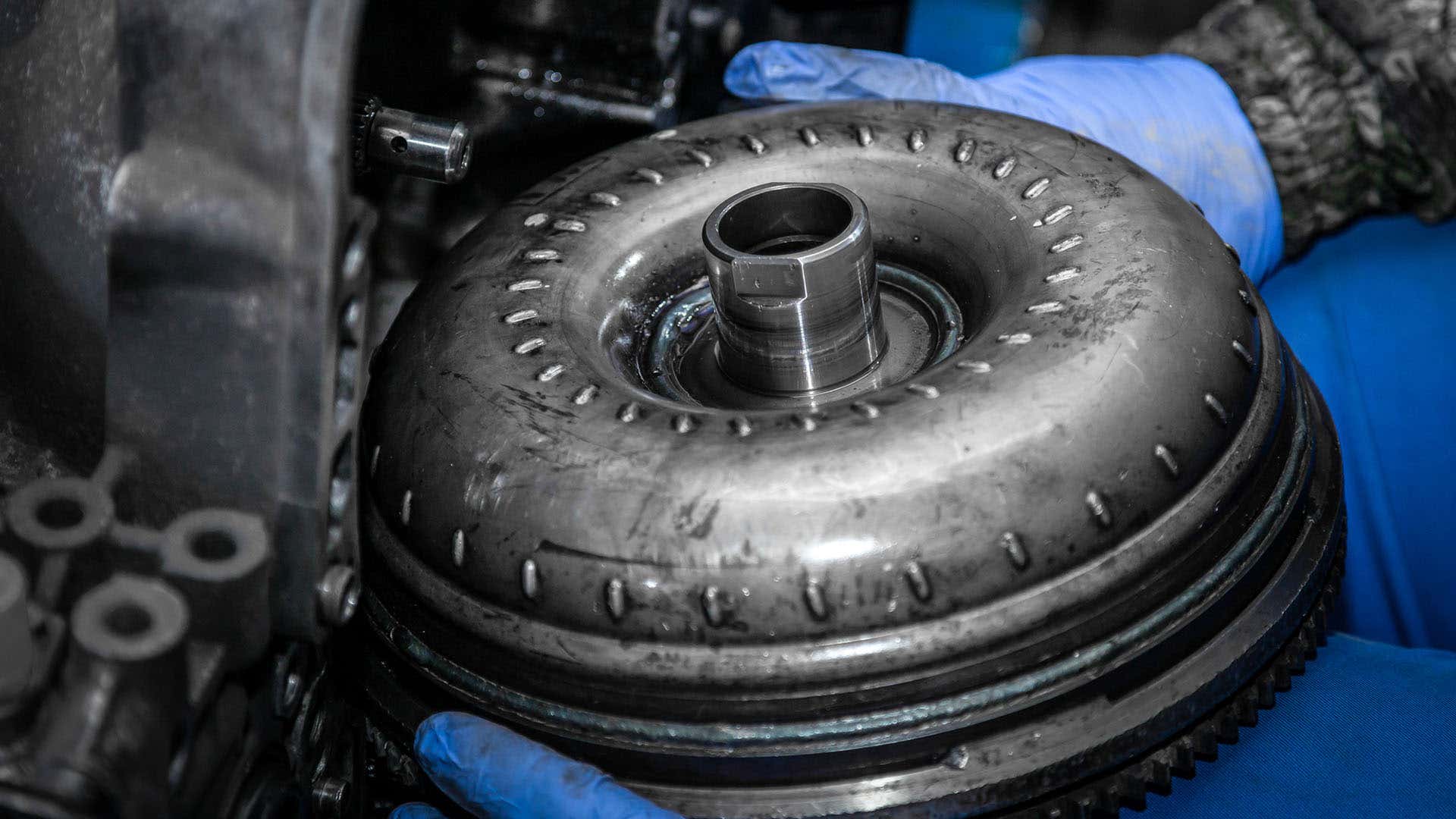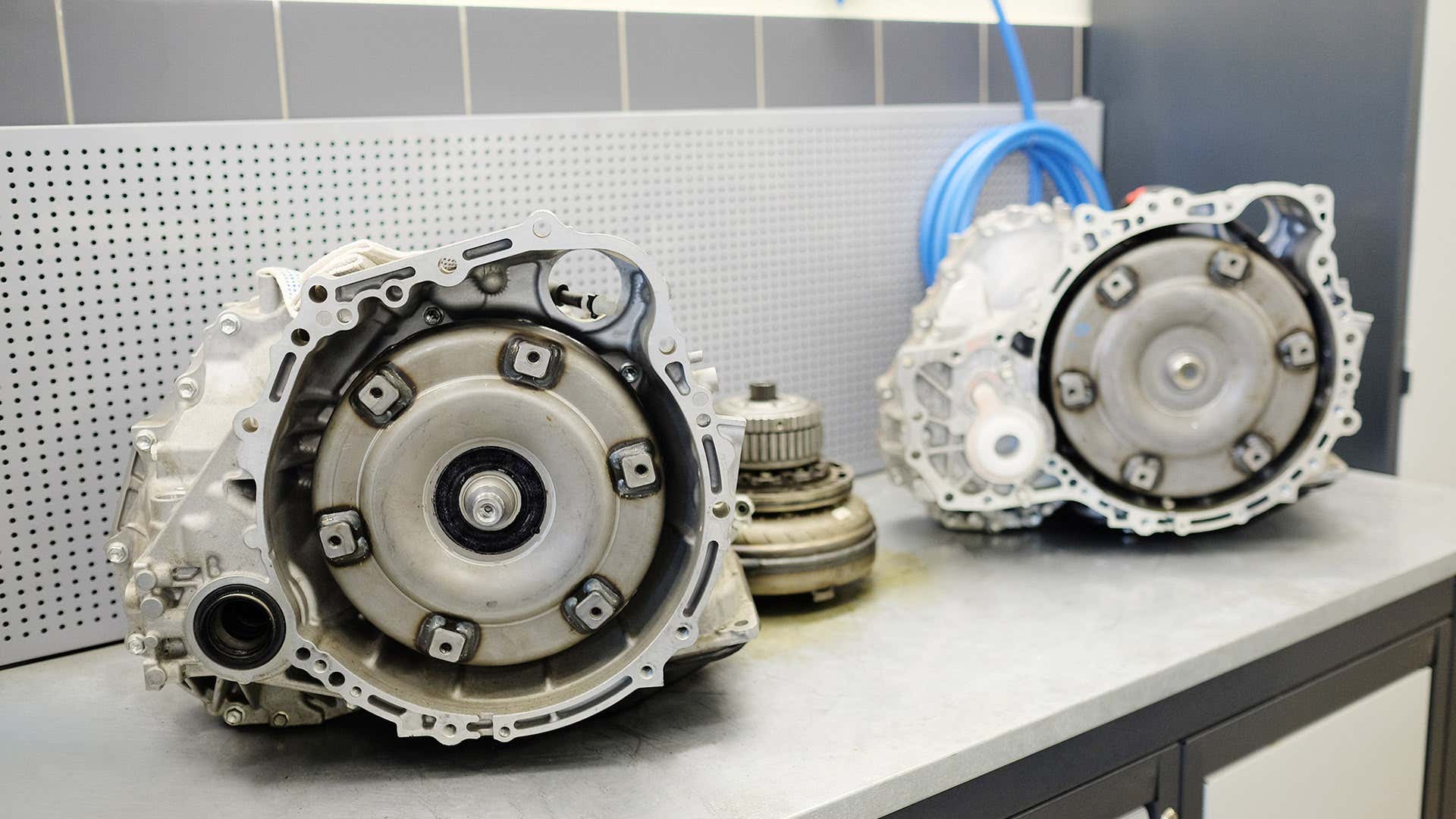The Drive and its partners may earn a commission if you purchase a product through one of our links. Read more.
An automatic transmission is kinda like a parent of a three-year-old child; it does everything for the driver. Want to reverse? Just move the shift lever to R. Want to drive? Put the lever in D, and the driver never has to worry about shifting gears. With the stab of a pedal, the car can quickly speed to 70 mph or stop on demand.
Automatic transmissions make simple errands seem uneventful and pedestrian, but underneath their metal shells, there are numerous complex processes taking place, including within the gear sets and torque converter. Between the engine and the complicated gear sets, a torque converter provides an interconnecting link, and without it, the car wouldn’t move.
To better understand how an automatic transmission works, it’s key to understand how a torque converter works. The Drive’s greasy informational team is here to break down its inner workings, and explain how all the parts come together to perform one central purpose. Let’s get it.
What is a Torque Converter?
A torque converter is a device inside an automatic transmission housing set between the engine and the gears. Essentially an advanced hydraulic fluid coupling, the torque converter transmits and multiplies engine torque while also allowing the vehicle to come to a complete stop without touching or shifting the transmission. In the past, cars used non-locking torque converters, but most modern vehicles use lock-up torque converters.
Lock-Up
A lock-up torque converter has a built-in locking clutch mechanism. Once the transmission senses a specific speed or engine RPM, the torque converter will use the clutch to lock in a direct connection between the input and output shafts for better efficiency.
Non-Lock-Up
Before lock-up clutches were invented to maximize efficiency, we basically accepted the energy loss that occurs during the transfer of power between the engine and the transmission due to slippage. Without a clutch to lock up the torque converter, the turbine can still rotate up to approximately 90 percent as fast as the impeller, but they do not reach equal speeds. Thus, energy loss.
A torque converter kind of looks like a giant donut.
What’s Inside a Torque Converter?
A torque converter is typically made of four major components: an impeller, a stator, a turbine, and a clutch plate. These pieces work together in a fluid-filled housing. Let’s break down exactly what each part does.
Impeller
The impeller, sometimes known as a pump, is attached to and spins with the engine’s crankshaft. As the impeller spins, its blades catch fluid, and centrifugal force pushes the fluid to the outside of the impeller. The faster it spins, the higher the force. This fluid is thrown into the turbine, which is facing the opposite direction toward the impeller.
Turbine
When the fluid hits the turbine’s blades, the turbine spins and funnels the fluid to the center of the turbine and back across toward the stator and impeller. This cycle continues in a circular motion. The turbine output shaft acts as the input shaft to the rest of the transmission.
Stator
Torque cannot be converted without the stator, sometimes called the reactor—don’t worry, not the Chernobyl kind. The stator, a small impeller-like device centrally sandwiched between the impeller and the turbine, receives fluid from the turbine and determines the fluid flow rate. Due to the specific angle of the stator blades, the fluid flows back at a slower rate, which multiplies the torque.
Clutch
At specific speeds or RPMs, a friction clutch plate will engage to lock the turbine to the impeller to maintain even rotational speeds between the two.
An automatic transmission would not work without a torque converter.
How Do Torque Converters Work?
A torque converter functions differently depending on the driver’s input. These three stages determine what’s going on: stall, acceleration, and coupling.
Stall
This occurs when the vehicle is not in motion or comes to a stop due to braking. Stalling does not suggest the vehicle stalls out and dies, rather it means the impeller is rotating but the turbine is not. Thus, the engine is running, but the vehicle is not moving.
Acceleration
When the driver hits the gas pedal, the impeller increases its rotational speed. The turbine is moving at a lower speed, and this is when torque multiplication occurs.
Coupling
Coupling occurs when the vehicle is moving at high speeds and the turbine is rotating at nearly the same speed as the impeller. When this occurs, the clutch engages and locks the impeller to the turbine so they rotate at the same speed.
What Are The Signs Of A Bad Torque Converter?
You’ll know when your transmission is faltering. How? When you feel one of these symptoms:
Slipping and/or Lagging Acceleration
If you notice the transmission slipping, as in failing to succinctly step through the gears, a failing torque converter could be the cause. It will feel like the power starts and sputters as you accelerate.
Shuddering or Shaking
Good automatic transmissions should shift so smoothly that the driver barely notices. If your ride is shuddering, shaking, or vibrating while it’s trying to change gears, it could be an indication the torque converter is on its way out.
Whirring or Humming Sounds
Automatic transmission should not make any strange sounds if they are running correctly. If something is wrong with the torque converter, the driver might notice a quiet humming or whirring sound coming from the transmission.
Leaks
Automatic transmissions, and the torque converters inside of them, are both filled with transmission fluid. If one of the many seals on the transmission fails, fluid could leak out and put your transmission in danger. If you notice drops of fluid, inspect the source and immediately make any necessary repairs.
How Much Does It Cost To Replace A Torque Converter?
If you choose to replace the torque converter yourself, the part itself will likely cost approximately $100-600, depending on the vehicle. But that means you’ll be dropping the transmission yourself. If you choose to take your issue to a shop, it will likely cost between $500-1,000.
Should I Repair a Torque Converter Myself?
Unless you have an experienced friend who has done this type of work before to guide you along (we’d happily do house calls, but pandemic, you know?), it might be best for inexperienced garage mechanics to leave transmission problems to the pros. They’re extremely complicated, and getting to them requires detachment from the engine, which can be a massive job without the right tools. In this case, it might be best for you to take it in.
Featured Products
Red Line API GL-4 Manual Transmission and Transaxle Lubricant, 1 Quart
ACDelco Professional Dexron Synthetic Automatic Transmission Fluid, 1 Quart
Castrol Transmax Dex/Merc Synthetic Automatic Transmission Fluid, 1 Gallon
Got a question? Got a pro tip? Send us a note: [email protected]
Source: Read Full Article


